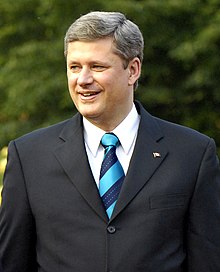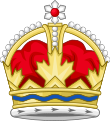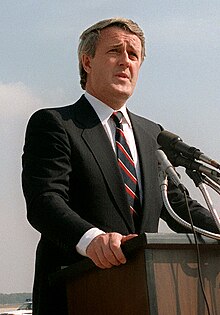| Revision as of 07:09, 17 January 2010 view source174.7.14.105 (talk)No edit summary← Previous edit | Revision as of 17:05, 17 January 2010 view source GoodDay (talk | contribs)Autopatrolled, Extended confirmed users, Pending changes reviewers495,197 editsNo edit summaryNext edit → | ||
| Line 8: | Line 8: | ||
| |image = Stephen Harper G8 2007.jpg | |image = Stephen Harper G8 2007.jpg | ||
| |incumbent = ] | |incumbent = ] | ||
| |incumbentsince = ''6 February 2006'' | |||
| |appointed_by = ] | |appointed_by = ] | ||
| |governor = ] | |governor = ] | ||
Revision as of 17:05, 17 January 2010
| {{{post}}} | |
|---|---|
 Incumbent IncumbentStephen Harper since 6 February 2006 | |
| Residence | 24 Sussex Drive, Ottawa |
| Website | www.pm.gc.ca |
| Politics of Canada |
|---|
 |
| Government (structure) |
| The Crown |
| Executive |
| Legislative |
| Judicial |
| Elections |
| Local government |
|
Foreign relations
|
| Crown and Indigenous peoples |
| Related topics |
The Prime Minister of Canada (Template:Lang-fr) is the primary Minister of the Crown, chairman of the Cabinet, and thus head of government for Canada, charged with advising the Canadian monarch or viceroy on the exercise of the executive powers vested in them by the constitution. Not outlined in any constitutional document, the office exists only as per long-established convention originating in Canada's former colonial power, the United Kingdom, which stipulate that the monarch's representative, the Governor General of Canada, must select as Prime Minister the person most likely to command the confidence of the elected House of Commons; this individual is typically the leader of the political party that holds the largest number of seats in that chamber.
The current, and 22nd, Prime Minister of Canada is the Conservative Party's Stephen Harper, who was appointed as such on 6 February 2006 by Governor General Michaëlle Jean, following the general election that took place that year. As with all other Canadian Prime Ministers, Harper is styled as The Right Honourable (Template:Lang-fr), a privilege maintained for life.
Qualifications and selection
Further information: List of Prime Ministers of CanadaThe Prime Minister, along with the other ministers in Cabinet, is appointed by the Governor General on behalf of the Queen. However, by the conventions of responsible government, designed to maintain administrative stability, the viceroy will almost always call to form a government the leader of that political party which holds the most seats in the directly elected House of Commons. Legally, this may be any citizen of Canada of voting age (18 years and over)– the requirements to gain election to the House of Commons. It is not actually clear as to whether there are age or citizenship restrictions on the position of Prime Minister itself, as it is not necessary for the incumbent to be a sitting Member of Parliament (MP). However, this is more of an academic quesition since the constitutional conventions involved in selecting the Prime Minister make the appointment of anyone ineligible for election to the House an obvious infeasibility.
In rare circumstances individuals who are not members of the House can be appointed Prime Minister. Two former Prime Ministers– Sir John Joseph Caldwell Abbott and Sir Mackenzie Bowell– served in the 1890s while members of the Senate; both, in their roles as Government Leader in the Senate, succeeded Prime Ministers who died in office (John A. Macdonald in 1891 and John Sparrow David Thompson in 1894), a convention that has since evolved toward the appointment of an interim leader in such a scenario. It should be noted that the Senate was considered a much more powerful body in the first half century after Confederation. By the 1920s however the Senate had lost much of its original influence, and hence no sitting Senator had been known to have serious aspirations of becoming Prime Minister whilst remaining in the Senate. Prime Ministers who are not Members of Parliament upon their appointment (or who lose their seats while in office) have since been expected to seek election to the House as soon as possible. For example William Lyon Mackenzie King, after losing his seat in the same general election that his party won, briefly "governed from the hallway" before winning a by-election a few weeks later. Similarly, John Turner replaced Pierre Trudeau as leader of the Liberal Party in 1984 and subsequently was appointed Prime Minister even though he did not hold a seat in the lower chamber of parliament; Turner won a riding in the next election but the Liberal Party was swept from power. Turner was the last sitting Prime Minister to not hold a Commons seat.
Since Turner's brief premiership, should a sitting provincial premier today lose his seat in the legislature (or should a new premier be appointed without holding a seat), the typical process that follows is that a junior member in the premier's party will immediately resign to allow the premier to run in the resulting by-election. A safe seat is usually chosen since the old convention of major parties not opposing a new leader in by-elections is rarely honored today. However, if the governing party selects a new leader shortly before an election is due, and that new leader is not a member of the legislature, he or she will normally await the upcoming election before running for a seat in the legislature. This convention would likely be adhered to at the federal level.
Mandate

The Canadian Prime Minister serves At Her Majesty's Pleasure, meaning the post does not have a fixed term; once appointed and sworn in by the Governor General, the Prime Minister remains in office until he or she resigns, is dismissed, or dies. The lifespan of parliament is limited by the constitution to five years, and, after 2007, by the Canada Elections Act to four years, though the Governor General may still, on the advice of the Prime Minister, dissolve parliament and issue the writs of election prior to the expiry of four years; the King-Byng Affair was the only time since Confederation that the viceroy deemed it necessary to refuse his Prime Minister's request for a general vote.
Following parliamentary dissolution, the Prime Minister must run in the resulting general election if he or she wishes to maintain a seat in the House of Commons. Should the Prime Minister's party win such an election, it is unnecessary to re-appoint the Prime Minister or again swear him or her into office. If, however, an opposition party wins a majority of seats in the House of Commons, the Prime Minister is required to resign. Should the Prime Minister's party achieve a minority while an opposition party wins a plurality– i.e., more seats than any other party but less than a majority– the Prime Minister can attempt to maintain the confidence of the House by forming a coalition with other minority parties; this option has almost never been entertained in Canada, the last time being in 1925.
Role and authority
Further information: Queen's Privy Council for Canada
Because the Prime Minister is, in practice, the most politically powerful member of the Canadian government, he or she is sometimes erroneously referred to as Canada's head of state, when, in fact, that post is held by the Canadian monarch, represented by the Governor General. The Prime Minister is, instead, the head of government, responsible for giving advice to the monarch or the viceroy on how to exercise the Royal Prerogative and executive powers given to them by the written and unwritten tenets of the constitution. However, the function of the Prime Minister, modelled on the same office in the United Kingdom, has evolved with increasing power. Today, as per the doctrines of constitutional monarchy, the advice given by the Prime Minister is ordinarily binding, meaning the Prime Minister effectively carries out those duties ascribed to the sovereign and/or Governor General, leaving the latter to act in predominantly ceremonial fashions. As such, the Prime Minister, supported by the Office of the Prime Minister (PMO), controls the appointments of many key figures in Canada's system of governance, including the Governor General, the Cabinet, Justices of the Supreme Court, Senators, heads of Crown corporations, ambassadors to foreign countries, the provincial Lieutenant Governors, and approximately 3,100 other positions. Further, the Prime Minister plays a prominent role in the legislative process– with the majority of bills put before parliament originating in the Cabinet (a group of Ministers of the Crown selected and headed by the premier)– and the leadership of the Canadian Forces.


Pierre Trudeau is credited with, throughout his tenure as Prime Minister between 1968 and 1984, consolodating power in the PMO, which is itself filled by political and administrative staff selected at the Prime Minister's discretion. However, at the end of the 20th century and into the 21st, analysts– such as Jeffrey Simpson, Donald Savoie, and John Gomery– argued that both parliament and Cabinet had become eclipsed by prime ministerial power; indeed, the position has been described as undergoing a "presidentialisation", to the point that its incumbents publicly outshine the actual head of state. Savoie quoted an anonymous minister from the Liberal Party as saying Cabinet had become "a kind of focus group for the Prime Minister," while Simpson called Cabinet a "mini-sounding board". It has been theorised that such is the case in Canada as its parliament is less influential on the executive than in other countries with Westminster parliamentary systems; particularly, Canada has fewer Members of Parliament, a higher turnover rate of MPs after each election, and an Americanised system for selecting political party leaders, leaving them accountable to the party membership rather than caucus, as is the case in the United Kingdom.
There do exist checks on the Prime Minister's power: parliament may revoke its confidence in an incumbent Prime Minister; Cabinet or caucus revolts can quickly bring down a sitting premier, and even mere threats of such action can persuade and/or compel a Prime Minister to resign his post, as happened with Jean Chrétien; the Senate may delay or impede legislation put forward by the Cabinet, such as when Brian Mulroney's bill creating the Goods and Services Tax (GST) came before the upper chamber; and, given Canada's federal nature, the jurisdiction of the federal government is limited to areas prescribed by the constitution. Further, though it may appear otherwise, executive power is constitutionally vested in the monarch, meaning the Royal Prerogative belongs to the Crown and not to any of its ministers, the sovereign's supremacy over the Prime Minister in the constitutional order thus being seen as a "rebuff to the pretensions of the elected: As it has been said, when the Prime Minister bows before the Queen, he bows before us ." Either the sovereign or his or her viceroy may therefore oppose the Prime Minister's will in extreme, crisis situations. Near the end of her time as Governor General, Adrienne Clarkson stated: "My constitutional role has lain in what are called 'reserve powers': making sure that there is a prime minister and a government in place, and exercising the right 'to encourage, to advise, and to warn' Without really revealing any secrets, I can tell you that I have done all three."
Privileges

Two official residences are provided to the Prime Minister– 24 Sussex Drive in Ottawa and Harrington Lake, a country retreat in Gatineau Park– as well as an armoured, long-wheelbase Cadillac STS and two official aircraft– a CC-150 Polaris for international flights and a Challenger 601 for domestic trips. The Royal Canadian Mounted Police also furnish constant personal security for the premier and his or her family. All of the aforementioned is supplied by the Queen-in-Council through budgets approved by parliament, as is the Prime Minister's annual salary of CAD$301,600. Only about half of this income is specific to the role of Prime Minister, the remainder being the normal salary of a Member of Parliament.
Sitting or former Prime Ministers are accorded state funerals, wherein their casket lies in state in the Centre Block of Parliament Hill. Only Mackenzie Bowell and The Viscount Bennett were given private funerals, Bennett also being the only Prime Minister of Canada to die and be buried outside the country and Bowell the only to not have politicians attend his funeral services.
In earlier years, it was traditional for the monarch to bestow a knighthood on newly appointed Canadian Prime Ministers. As such, several carried the prefix sir before their name; of the first eight premiers of Canada, only Alexander Mackenzie refused the honour of a knighthood from Queen Victoria. Following the 1919 Nickle Resolution, however, it was against non-binding policy for the sovereign to grant such honorific titles to Canadians; the last Prime Minister to be knighted was Sir Robert Borden, who was premier at the time the Nickle Resolution was debated in the House of Commons. Still, Richard Bennett was in 1941, six years after he stepped down was Prime Minister, elevated to the peerage by King George VI as The Viscount Bennett of Mickleham in the County of Surrey and of Calgary and Hopewell.
See also
Notes
- Savoie offered the critique: "Cabinet has now joined Parliament as an institution being bypassed. Real political debate and decision-making are increasingly elsewhere—in federal-provincial meetings of first ministers, on Team Canada flights, where first ministers can hold informal meetings, in the Prime Minister's Office, in the Privy Council Office, in the Department of Finance, and in international organizations and international summits. There is no indication that the one person who holds all the cards, the prime minister, and the central agencies which enable him to bring effective political authority to the centre, are about to change things. The Canadian prime minister has little in the way of institutional check, at least inside government, to inhibit his ability to have his way.
- See Note 1 at Queen's Privy Council for Canada.
Footnotes
- Brooks, Stephen (2007). Canadian Democracy: An Introduction (5 ed.). Don Mills: Oxford University Press. pp. 233–234. ISBN 978-0195431032.
- ^ Brooks 2007, p. 235 harvnb error: no target: CITEREFBrooks2007 (help)
- Office of the Governor General of Canada. "Media > Fact Sheets > The Swearing-In of a New Ministry". Queen's Printer for Canada. Retrieved 18 May 2009.
- Forsey, Eugene (2005), How Canadians Govern Themselves (PDF) (6 ed.), Ottawa: Queen's Printer for Canada, pp. 3–4, ISBN 0-662-39689-8, retrieved 9 December 2009
- ^ Forsey 2005, p. 38 harvnb error: no target: CITEREFForsey2005 (help)
- ^ Forsey 2005, p. 5 harvnb error: no target: CITEREFForsey2005 (help)
- Brooks 2007, pp. 233–235 harvnb error: no target: CITEREFBrooks2007 (help)
- Brooks 2007, p. 258 harvnb error: no target: CITEREFBrooks2007 (help)
- Jackson, Michael D. (2009). "The Senior Realms of the Queen" (PDF). Canadian Monarchist News. Autumn 2009 (30). Toronto: Monarchist League of Canada: 10. Retrieved 17 January 2010.
- Savoie, Donald (1999). Governing from the Centre: The Concentration of Power in Canadian Politics. Toronto: University of Toronto Press. p. 260. ISBN 978-0802082527.
- Savoie 1999, p. 362 harvnb error: no target: CITEREFSavoie1999 (help)
- Simpson, Jeffrey (2001). The Friendly Dictatorship. Toronto: McClelland & Stewart. p. 248. ISBN 978-0771080791.
- Foot, Richard (15 January 2010), "Only in Canada: Harper's prorogation is a Canadian thing", National Post, retrieved 16 January 2010
- MacLeod, Kevin S. (2008), A Crown of Maples (PDF) (1 ed.), Ottawa: Queen's Printer for Canada, p. 16, ISBN 978-0-662-46012-1, retrieved 21 June 2009
- Cox, Noel (September 2002). "Black v Chrétien: Suing a Minister of the Crown for Abuse of Power, Misfeasance in Public Office and Negligence". Murdoch University Electronic Journal of Law. 9 (3). Perth: Murdoch University: 12. Retrieved 17 May 2009.
- Neitsch, Alfred Thomas (2008). "A Tradition of Vigilance: The Role of Lieutenant Governor in Alberta" (PDF). Canadian Parliamentary Review. 30 (4). Ottawa: Commonwealth Parliamentary Association: 23. Retrieved 22 May 2009.
- Coyne, Andrew (13 November 2009). "Defending the royals". Maclean's. Toronto: Rogers Communications. ISSN 0024-9262. Retrieved 17 November 2009.
- Coyne, Andrew (10 April 2002), "A lightning rod for patriotic love", National Post, retrieved 22 May 2006
- "GG reflects on mandate during farewell address". CTV. 14 September 2005. Retrieved 8 August 2007.
- Naumetz, Tim (18 April 2007), "Raise boosts MPs' base salary to $150,800", Ottawa Citizen, retrieved 10 December 2009
- State Funerals in Canada. "Frequently Asked Questions on State Funerals in Canada". Queen's Printer for Canada. Retrieved 10 December 2009.
- Library of Parliament. "Federal Government > Prime Ministers of Canada > Biographical Informarion > BENNETT, The Right Hon. Richard Bedford, P.C., K.C., K.G.St.J., LL.B." Queen's Printer for Canada. Retrieved 10 December 2009.
External links
- Official government Web site of the Office of the Prime Minister
- Prime Minister of Canada on YouTube
- Library of Parliament of Canada
- Historians rank the Best and Worst Canadian Prime Ministers: 1997 Maclean's article
- Maple Leaf Web: The Prime Minister & Cabinet
- "CBC News in Depth: Canadian Government". CBC. 2004-09-28. Retrieved 2007-03-17.
| Prime ministers of Canada | |
|---|---|
| Lists related to prime ministers of Canada | |||
|---|---|---|---|
| List of prime ministers | |||
| Premiership |
| ||
| Personal life | |||
| Related positions | |||
| Related lists | |||
| Canada | |||||
|---|---|---|---|---|---|
| History |
| ||||
| Provinces and territories |
| ||||
| Geography |
| ||||
| Government |
| ||||
| Economy | |||||
| Demographics |
| ||||
| Society | |||||
| Culture |
| ||||
| Contents | |||||
| Research | |||||